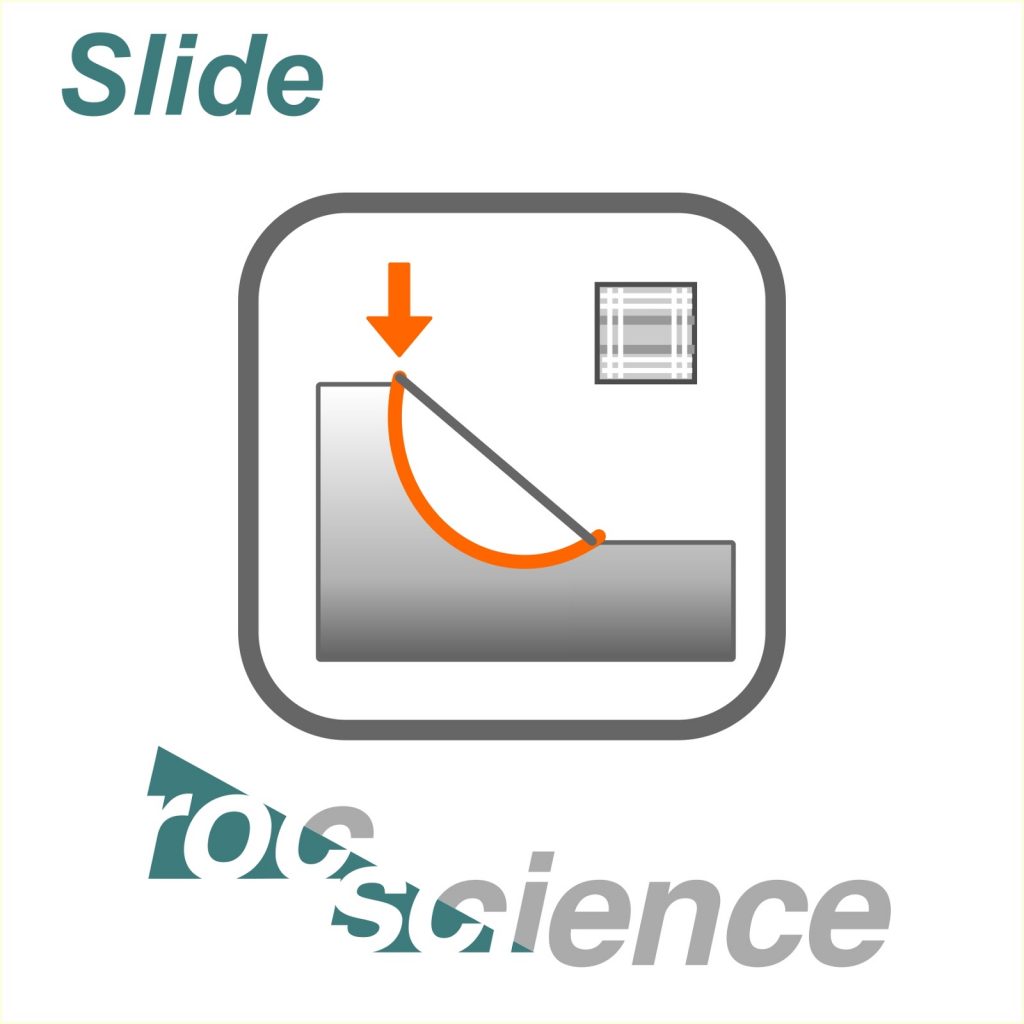Rocscience Slide 2018 – Deskripsi, Fitur Dan Harga

Slide2
Slide2 is a powerful, user-friendly, 2D slope stability analysis program using limit equilibrium method. Slide2 can be used for all types of soil and rock slopes, embankments, earth dams, and retaining walls. Slide2 includes built-in finite element groundwater seepage analysis, probabilistic analysis, multi-scenario modeling, and support design.
Slide2 (formerly “Slide”) is a 2D slope stability program for evaluating the safety factor or probability of failure, of circular and non-circular failure surfaces in soil or rock slopes. Slide2 is simple to use, and yet complex models can be created and analyzed quickly and easily. External loading, groundwater and support can all be modeled in a variety of ways.
Slide2 analyzes the stability of slip surfaces using vertical slice or non-vertical slice limit equilibrium methods like Bishop, Janbu, Spencer, and Sarma, among others. Individual slip surfaces can be analyzed, or search methods can be applied to locate the critical slip surface for a given slope. Users can also carry out deterministic (safety factor) or probabilistic (probability of failure) analyses.
Groundwater Analysis with Slide2
Finite element groundwater (seepage) analysis, for steady state or transient conditions, is built right into Slide2.
Probabilistic Slope Stability with Slide2
Slide2 also has extensive probabilistic modeling and analysis features. Nearly all model input parameters can be defined as random variables, so that a probability of failure or reliability index may be calculated. Sensitivity Analysis can also be carried out. See the Probabilistic Analysis Overview topic for more information.
Slide 2018: A preview
A new version of Slide is due to be released in early 2018, and will be known as Slide 2018 (or, sequentially, Slide version 8). This article will give a sneak preview of the new features we are working on.
Slide 2018 youtube
Improved Scenario Manager
The multi-scenario modeling feature introduced in Slide version 7 has proved to be one of the most popular and extensively used options in the program. Based on customer feedback, some important improvements to this feature have been made in Slide 2018.
New Master Scenario
A new master scenario file has been introduced, which allows you to more easily propagate changes to all scenarios in a group. Simply edit the master scenario file and all changes will automatically propagate to all scenarios in the group.
Link scenarios
A new “link” feature has replaced the previous “lock” feature. Linking allows you to easily propagate changes to user-selected scenarios, instead of all scenarios.
Speed improvements
To our surprise we found that some customers were
creating multi-scenario Slide files with dozens or in some cases over one hundred scenarios. This led to speed issues in editing and file management. In Slide 2018 the multi-scenario file manager has been optimized to handle large numbers of scenarios with no slow down in performance.
Surface Altering Optimization
For the critical slip surface search, a new optimization method has been added – Surface Altering Optimization. This option has been shown to be much faster (10 to 15 times) than the Monte Carlo algorithm for most cases, and is the new default search optimization method for non-circular slip surfaces.
Spatial variability of material properties
A new probabilistic analysis option – spatial variability – has been added to the already extensive probabilistic analysis capabilities in Slide.
Most real geotechnical materials have properties which vary with location within the material, to some extent. This type of variability is not accounted for in a standard probabilistic analysis, which assumes a single value of each material parameter over an entire soil region, for each statistical sampling.
With spatial variability analysis, a correlation length is defined for each material which is used to generate a random field for that material. For each sampling, a new random field is generated. Considering spatial variability of soil properties has been shown to improve the mean factor of safety and probability of failure calculated for
a probabilistic analysis. We are pleased to offer this new analysis tool for probabilistic slope stability.
The correlation length determines the scale of variation of properties within a material (smaller correlation length corresponds to higher variability of material in the slope profile), as illustrated below for a random field of cohesion,
using two different correlation lengths (20 meters and 1 meter). The results below represent one statistical sampling (i.e. one instance of a random field). A full analysis will generate a new random field per material with each sampling.
Anisotropic Surfaces
Slide has several different options for modeling anisotropic material strength. In Slide 2018 a new option has been added which makes it simple to model an anisotropic material with a variable orientation, such as a folded bedding layer.
With the new Anisotropic Surface option, the user simply defines a polyline which follows the orientation of the anisotropy for a given material. The compute engine then uses this polyline to determine the local orientation of the bedding relative to the slip surface at any location, to apply the correct material strength, using the anisotropic strength envelope.
Weak Layers
In previous versions of Slide, a weak layer had to be modeled as a material zone of finite thickness bounded by two material boundaries. In Slide 2018, a new boundary type has been added which allows you to define a weak layer using only a single polyline. This can be used to model joints or other types of interfaces along which sliding may
occur. This option is intended to be used for thin weak layers of negligible thickness (e.g. a geosynthetic liner).
The search algorithm will attempt to follow the weak layer while searching for the global minimum slip surface.
Generalized Hoek-Brown
An improvement has been made in the input for the
Generalized Hoek-Brown material model. Users can now directly input the parameters GSI, mi and D, in the Material Properties dialog, since these are usually the known parameters. Furthermore, an additional new option allows you to define the parameters GSI, mi and D as variable with depth, by selecting the checkbox shown below.
Newmark Seismic Option
An improvement to the Newmark seismic analysis option allows you to run all methods simultaneously (rigid, coupled, decoupled), rather than having to run the analysis separately for each method. Results for all methods are then available for viewing.
Material Property Viewer
A new option allows the contouring of material properties and other data directly on the model. Originally developed for contouring spatially variable data (as shown in the above figures), this option will also extend to other data types (e.g. cohesion which varies by depth, friction angle, unit weight, water pressure, etc.).
What’s New in Slide 2018 (version 8.0)
The following is a listing of the major additions which have been made in the upgrade of Slide from version 7 to Slide 2018 (version 8).
Note: for a list of changes and bug fixes since the initial release of Slide 2018, see the Slide 2018 Update History page.
Improved Scenario manager
- Master scenario – group folder is now a master scenario file, automatically propagate edits to all sub-scenarios
- Link scenarios – select any scenarios in a group to link for editing
- Speed improvements of 1.5 to 3 times for file open/save for large multi scenario files
Spatial statistics
- Spatial variability of material properties
- Define correlation length for random variables
- Plot random fields with property viewer
- Correlate spatially variable properties within a material
- Filter and view worst case random fields and slip surfaces
- Apply spatial variability to undrained linearly increasing cases
- Live preview of effect of correlation length on random field
- Three covariance function options for field generation
Support
- Two new pile models (Equivalent Fluid Pressure and Ito & Matsui) and launched soil nail model
- Ito & Matsui pile model: Ito & Matsui (1975) model for pile surrounded by plastically deforming ground
- EFP pile model: ability to input equivalent fluid weight and apply the resultant force at a fraction from the slip surface intersection
- Launched Soil Nail Model – used for soil nails that are launched instead of drilled or driven. Uses the FHWA 1994 Application Guide for Launched Soil Nails.
Speed Improvements
- Significant improvements to the speed of most search methods (e.g. Cuckoo, Simulated Annealing, non-circular optimization)
- Improvements to compute speed
Anisotropic Surface
- Add a surface to define the direction of anisotropy for non-linear anisotropic material layers (e.g. folded bedding)
- Used in conjunction with Anisotropic Linear or Snowden Modified Anisotropic Linear strength models
Generalized Hoek-Brown
- Improved input – explicit option to use mb, s, a or GSI, mi, D as input for the criterion
- Vary parameters by depth or distance from slope (GSI, mi, D) if using the GSI, mi, D input option
Weak Layer
- Weak layer boundary – assign strength properties to boundary
- Model sliding along joints or weak surfaces (e.g. geosynthetic liner interface)
Property Viewer
- Input parameters which vary by location can now be contoured on the model (e.g. spatial variables or variable by depth)
- Contour spatially variable material properties (cohesion, friction angle, unit weight)
- Filter and view worst case random fields and slip surfaces
- Contour GSI, mi, D (variable by depth) for Generalized Hoek-Brown
- Pore pressure contours
- Discrete strength function contours
- Select materials to contour
Slip Surface Search Methods
- Surface altering optimization – new option for non-circular surface search optimization; faster than Monte Carlo and improved results for some models
- Particle swarm search
- Show all surfaces generated by cuckoo search or simulated annealing (previously only the global minimum was available, intermediate surfaces were not saved)
- Greatly improved speed for most search methods
Materials
- Improved material properties dialog (easy to add/delete/re-order materials)
- Infinite strength material – new option for sliding along the boundary
- Weak layer – assign strength properties to boundary
- Anisotropic surface
Newmark Seismic Analysis
- Run all methods together (rigid, coupled, uncoupled)
- Summary table of all methods
Miscellaneous
- Max number of properties in project settings no longer necessary
- Some changes to Statistics dialog input
- Project Summary removed from Project Settings, now a separate option
Previous Upgrades
- What’s New in Version 7.0
Kata Kunci Terkait:
Rocscience Slide 2018, jual Slide 2018 Rocscience, harga Slide 2018, spesifikasi Slide 2018, Slide 2018 youtube




